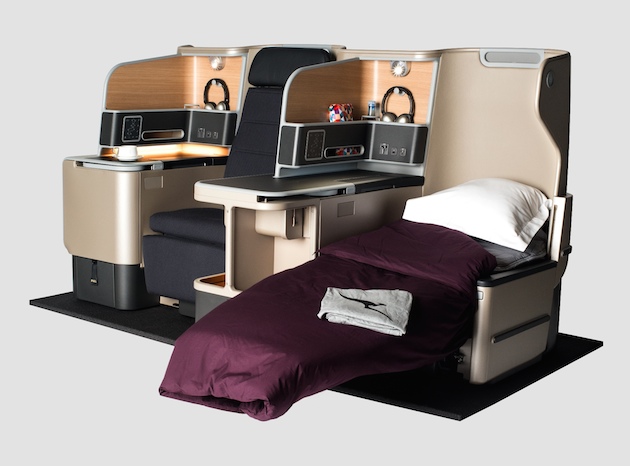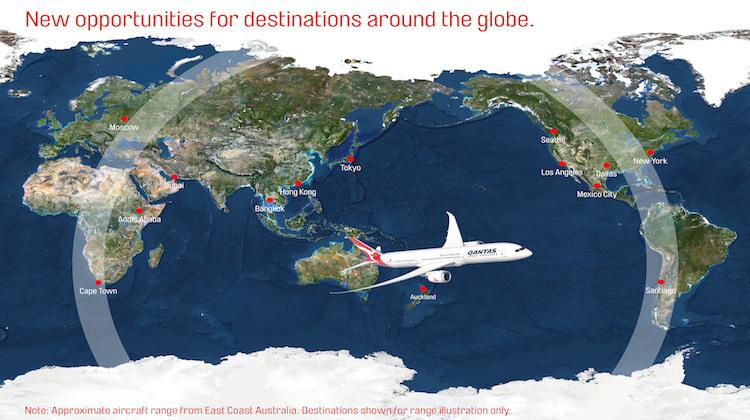
As more details emerge about Qantas’s selection of Boeing 787-9 Dreamliners for its future fleet, the passenger experience implications are fascinating, even given the background of the continued focus on costs and profitability within Qantas International.
“We are halfway through the biggest and fastest transformation in our history. Without that transformation, we would not be reporting this strong profit, recommencing shareholder returns, or announcing our ultra-efficient Dreamliner fleet for Qantas International,” Qantas Group chief executive Alan Joyce told reporters in Sydney on Thursday when presenting the company’s 2014/15 results.
Boeing now lists the 787-9 as capable of flying 7,635nm with 290 passengers in a two-class format. Joyce said on Thursday Qantas would fit the aircraft with about 250 seats across a three-cabin configuration that included business, premium economy and economy.
“We have looked closely at every aspect of the Dreamliner and it’s the right aircraft for Qantas’s future. The key reason we chose this particular aircraft is its incredible efficiency. Its new technology will reduce fuel burn, cut heavy maintenance requirements and open up new destinations around the globe. Because the 787 is smaller than the jumbos it will gradually replace, it gives us the flexibility of having more aircraft without significantly changing our overall capacity,” Joyce said.
“New aircraft types have always unlocked opportunities for Qantas. When our red-tail Dreamliners start arriving in two years’ time, their incredible range and fuel-efficiency will create new possibilities for our network. For customers, the Qantas Dreamliner’s improved cabin pressure, larger windows and technology to reduce turbulence will deliver the world’s best travel experience.”
And, indeed, if early indications pan out, everything is pointing to Qantas’s 787-9 Dreamliners being among the most spacious in the sky. The airline said that it would “work with its team of internal experts and external designers to develop world-leading cabin interiors for the new Dreamliner”.
The 250 seats that Qantas plans to configure its 787-9s is significantly fewer than on many other airlines’ -9 model Dreamliners, and a light load would also potentially extend the range of the aircraft.
While Qantas could try to claim a significant passenger experience advantage with an eight-abreast economy cabin, Joyce has hinted a nine-abreast configuration was the most likely option.
“Nine-abreast is the standard,” Joyce told Fairfax Media.
Nine-abreast economy on the 787 is more cramped than the 10-abreast economy on the 747-400 aircraft which it will replace.
In terms of range, given Qantas’s existing long-range Airbus A380 and Boeing 747-400ER aircraft it is not clear that there are all that many new nonstop flights that open up with the Dreamliner’s range – despite the airline releasing a thought-provoking range map labelled “new opportunities for destinations”, where New York remains tantalisingly just out of reach.
But the 787’s lower seat count and generational advance in operating economics will certainly allow new city pairs or increased frequencies on existing routes not viable with the bigger quad-jets. Joyce has offered Melbourne-Dallas Fort Worth as one potential option – which at 7,815nm is 180nm further than Boeing’s brochure range figure for the aircraft, which gives an indication of the extra range fewer seats might yield. And taking the soon-to-resume Sydney-San Francisco service to daily seems another logical 787-9 opportunity.
The real question for economy passengers, even more importantly given the prospect of a 16 hour Dallas flight, is whether the faint hope of an eight-abreast 2-4-2 layout on a 787 (currently only JAL has stumped for the extra space) might materialise on a Qantas 787-9.
By comparison among three-class -9 Dreamliners, Air New Zealand’s 787-9s seat 302 passengers in a leisure-heavy configuration, with 18 business seats ahead of doors 2, 21 premium economy seats and 263 nine-abreast economy seats that start at 31in (but are pitched at 33in in the six to eight rows of Skycouch ‘cuddle class’ seating). Air Canada’s seat 298 (30 business, 21 premium economy, 247 nine-abreast economy starting at 31in).
Virgin Atlantic’s focus on premium economy (with five rows rather than the more usual three) may be the most similar if Qantas decides on a high-premium economy layout, with a 264-seater -9 Dreamliner comprising 31 in business, 35 in premium economy, and 198 nine-abreast economy seats at 31in pitch.
ANA’s 787-9 Dreamliner is the least dense, seating 215 over 48 business class seats stretching for half the aircraft, 21 premium economy seats and just 146 nine-abreast economy passengers.
From an efficiency and accounting perspective, it’s hard to argue with the 12.5 per cent additional available seats that a nine-abreast 787-9 gives compared with an eight-abreast version of the same aircraft. But if there are other reasons for Qantas to be interested in packing fewer passengers on the aircraft, it might just be enough to create the second Dreamliner savvy economy passengers might actually want to fly in.
Offering a premium economy cabin seems likely too. If Qantas can point to a seven-abreast Dreamliner premium economy cabin as an option for passengers who want or need more space, it goes a small way towards mollifying the critics of nine-abreast.
Then up front, Qantas’s business offering on the 787-9 is likely to be based on the new A330-outfitted Business Suite, a Marc Newson-designed implementation of the Thompson Vantage XL staggered seat, which is also used by Aer Lingus and SAS. (The stagger comes from the feet of each passenger sliding forwards into an enclosed foot cubby under the side-table of the passenger in front.)
The Dreamliner’s cabin is 21cm wider than the A330’s (5.49m vs 5.28m), and Thompson advertises several options for seating density on the 787: eight, nine or ten seats per staggered pair of rows.
A selection of the eight seats per two rows option – which the 787-9’s planned 250-seat count suggests – would show Qantas still views itself as able to command a premium in the market, and is dedicated to ensuring its business class has direct aisle access for every passenger.
Read John Walton’s indepth analysis of Qantas 787 cabin fitout considerations in the August issue of Australian Aviation, currently on sale.











